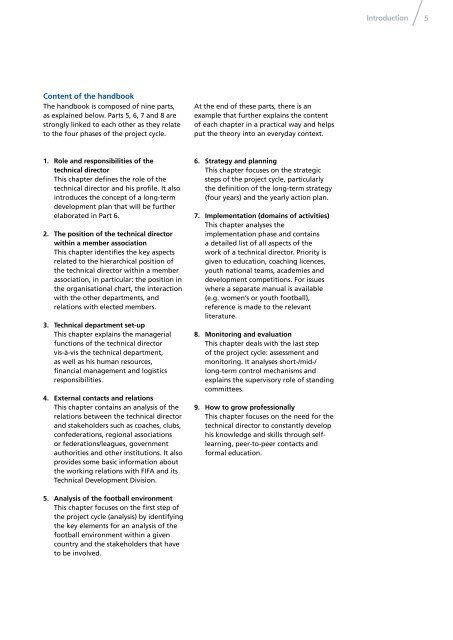handbook for Technical Directors
fifa_td_2016_e_low_neutral
fifa_td_2016_e_low_neutral
You also want an ePaper? Increase the reach of your titles
YUMPU automatically turns print PDFs into web optimized ePapers that Google loves.
Introduction<br />
5<br />
Content of the <strong>handbook</strong><br />
The <strong>handbook</strong> is composed of nine parts,<br />
as explained below. Parts 5, 6, 7 and 8 are<br />
strongly linked to each other as they relate<br />
to the four phases of the project cycle.<br />
At the end of these parts, there is an<br />
example that further explains the content<br />
of each chapter in a practical way and helps<br />
put the theory into an everyday context.<br />
1. Role and responsibilities of the<br />
technical director<br />
This chapter defines the role of the<br />
technical director and his profile. It also<br />
introduces the concept of a long-term<br />
development plan that will be further<br />
elaborated in Part 6.<br />
2. The position of the technical director<br />
within a member association<br />
This chapter identifies the key aspects<br />
related to the hierarchical position of<br />
the technical director within a member<br />
association, in particular: the position in<br />
the organisational chart, the interaction<br />
with the other departments, and<br />
relations with elected members.<br />
3. <strong>Technical</strong> department set-up<br />
This chapter explains the managerial<br />
functions of the technical director<br />
vis-à-vis the technical department,<br />
as well as his human resources,<br />
financial management and logistics<br />
responsibilities.<br />
4. External contacts and relations<br />
This chapter contains an analysis of the<br />
relations between the technical director<br />
and stakeholders such as coaches, clubs,<br />
confederations, regional associations<br />
or federations/leagues, government<br />
authorities and other institutions. It also<br />
provides some basic in<strong>for</strong>mation about<br />
the working relations with FIFA and its<br />
<strong>Technical</strong> Development Division.<br />
6. Strategy and planning<br />
This chapter focuses on the strategic<br />
steps of the project cycle, particularly<br />
the definition of the long-term strategy<br />
(four years) and the yearly action plan.<br />
7. Implementation (domains of activities)<br />
This chapter analyses the<br />
implementation phase and contains<br />
a detailed list of all aspects of the<br />
work of a technical director. Priority is<br />
given to education, coaching licences,<br />
youth national teams, academies and<br />
development competitions. For issues<br />
where a separate manual is available<br />
(e.g. women’s or youth football),<br />
reference is made to the relevant<br />
literature.<br />
8. Monitoring and evaluation<br />
This chapter deals with the last step<br />
of the project cycle: assessment and<br />
monitoring. It analyses short-/mid-/<br />
long-term control mechanisms and<br />
explains the supervisory role of standing<br />
committees.<br />
9. How to grow professionally<br />
This chapter focuses on the need <strong>for</strong> the<br />
technical director to constantly develop<br />
his knowledge and skills through selflearning,<br />
peer-to-peer contacts and<br />
<strong>for</strong>mal education.<br />
5. Analysis of the football environment<br />
This chapter focuses on the first step of<br />
the project cycle (analysis) by identifying<br />
the key elements <strong>for</strong> an analysis of the<br />
football environment within a given<br />
country and the stakeholders that have<br />
to be involved.


